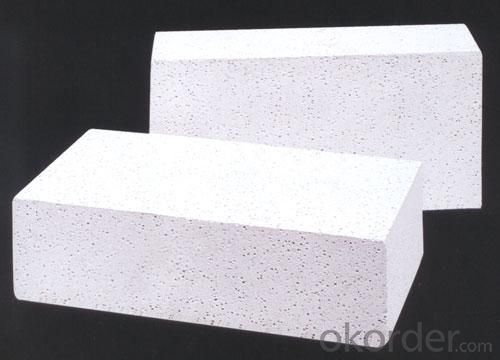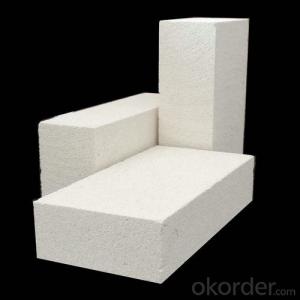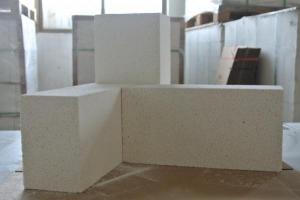Insulating Fire Brick for Steel Ladle Refractory Insulation
- Loading Port:
- Shanghai
- Payment Terms:
- TT OR LC
- Min Order Qty:
- 500 m.t.
- Supply Capability:
- 1000 m.t./month
OKorder Service Pledge
OKorder Financial Service
You Might Also Like
1.With high strength, high refractoriness, strong erosion resistance.
2.Can be customized according to customer's drawings for production.
3.The well block is suite with the nozzle , it can use in the steel making and the foundry,the tundish and ladle all can use it.The well block has long service life, no crack and no leak.
4. The well block use main the material with the high content of carbon and almnium or the zirconic.
5.We can produce the different shape according to the requirement of the client.
Refractory brick can be divided into three process: Raw material, molding, burning.Generally, refractory brick was molded by dry pressing. By means of mixing the material uniformity in proportion and aging mixture some time. Then, pour some powders into the module and dry pressing. After dry pressing, the adobe need to pushed in the drying kiln to stoving or stay in the air to drying. This progress will need about 3-5 days. After this progress, then push the adobe into the tunnel furnace or shuttle kiln to burning around 1300C. This progress will be need about 5-7 days.
After burning, the brick will be packed in pallet and leave the factory.
Item | Refractory Brick |
Applications | • Industrial furnace, glass furnace. • Chemical industrial furnace • Utility industry furnace lining. • Heat insulation ventilation wall. |
Features | • Resistance to High temperature, Resistance to erosion, resistance to abrasion • Excellent compression strength • Resistance to acid and alkali. • Excellent heat stability. |
- Q: Is it possible to recycle broken insulating fire bricks?
- Yes, it is possible to recycle broken insulating fire bricks. These bricks can be crushed and used as aggregate in the production of new bricks or other construction materials. Additionally, they can be ground into a fine powder and used as a raw material in the manufacturing of refractory products. Recycling broken insulating fire bricks helps reduce waste and conserve resources.
- Q: Can insulating fire bricks be used in refractory mortar?
- Yes, insulating fire bricks can indeed be used in refractory mortar. Insulating fire bricks are lightweight and have low thermal conductivity, which makes them ideal for applications where heat insulation is required, such as in kilns, furnaces, and other high-temperature environments. Refractory mortar, on the other hand, is specifically designed to withstand high temperatures and provide a strong bond between fire bricks or other refractory materials. By using insulating fire bricks in refractory mortar, you can achieve both heat insulation and structural integrity in your application.
- Q: Can insulating fire bricks be used in foundries?
- Yes, insulating fire bricks can be used in foundries. They are commonly used as lining materials for various high-temperature applications, including foundries. Insulating fire bricks provide excellent thermal insulation, reducing heat loss and improving energy efficiency in the foundry process. Additionally, they have good resistance to thermal shock and can withstand the extreme temperatures and harsh conditions often found in foundry environments.
- Q: Are insulating fire bricks resistant to chlorine gas?
- Generally, insulating fire bricks possess resistance to chlorine gas. These bricks are composed of refractory materials that are formulated to endure high temperatures and combat chemical corrosion. As chlorine gas is highly reactive, it has the potential to corrode or harm various materials. However, insulating fire bricks exhibit a strong resistance to chemical attack, thereby making them appropriate for situations where exposure to chlorine gas is likely. It should be noted that the composition and quality of these bricks may differ, hence it is advisable to consult the manufacturer or supplier for precise details regarding their resistance to chlorine gas.
- Q: Can insulating fire bricks be used in the construction of glass slump molds?
- Insulating fire bricks can indeed be utilized in the construction of glass slump molds. These bricks are composed of lightweight materials capable of enduring high temperatures, rendering them appropriate for kilns and other heat-intensive applications. When creating a glass slump mold, it is crucial to possess a material capable of withstanding the heat generated as the glass slumps and takes form. Insulating fire bricks offer the necessary insulation and heat resistance essential for this procedure. They can be cut and shaped to accommodate the desired mold design without succumbing to degradation or crumbling, even after repeated firings. As a whole, insulating fire bricks present a dependable and long-lasting choice for constructing glass slump molds.
- Q: Do insulating fire bricks have a high heat storage capacity?
- Yes, insulating fire bricks have a high heat storage capacity. Insulating fire bricks are specifically designed to have low thermal conductivity, which means they are able to retain heat for longer periods of time. This makes them ideal for applications where heat storage is necessary, such as in furnaces, kilns, and other high-temperature environments. The high heat storage capacity of insulating fire bricks allows for efficient heat retention and distribution, ultimately improving energy efficiency and reducing heat loss.
- Q: Are insulating fire bricks resistant to warping?
- Yes, insulating fire bricks are resistant to warping. They are specifically designed to have high thermal stability and low thermal conductivity, which helps to prevent warping even under high temperatures.
- Q: How do insulating fire bricks contribute to energy efficiency?
- Insulating fire bricks are a type of brick with high thermal resistance, which means they are excellent at preventing heat transfer. This property makes them a valuable component in energy-efficient systems. One way insulating fire bricks contribute to energy efficiency is by reducing heat loss. These bricks have low thermal conductivity, which means they don't easily conduct heat. As a result, they can effectively insulate areas where high temperatures are present, such as furnaces, kilns, and fireplaces. By minimizing heat loss, insulating fire bricks help keep the heat generated in these systems contained, allowing them to operate more efficiently. Moreover, insulating fire bricks also help reduce energy consumption. As they limit heat transfer, less energy is required to maintain the desired temperature within a system. This is particularly important in industries where high temperatures are essential for operations, as it can lead to significant energy savings. By using insulating fire bricks, companies can reduce their energy consumption, resulting in lower utility bills and a reduced environmental impact. Additionally, insulating fire bricks contribute to energy efficiency by improving the overall performance of heating systems. By providing insulation, these bricks help maintain a consistent and controlled temperature within the system. This ensures that the heat is evenly distributed and that there are no energy wastages due to temperature fluctuations. As a result, systems equipped with insulating fire bricks can operate more efficiently and effectively. In conclusion, insulating fire bricks play a crucial role in enhancing energy efficiency. Their high thermal resistance properties help reduce heat loss, minimize energy consumption, and optimize the performance of heating systems. By incorporating insulating fire bricks, individuals and industries can enjoy significant energy savings while also promoting a greener and more sustainable approach to energy consumption.
- Q: What is the maximum temperature that insulating fire bricks can withstand?
- Insulating fire bricks can withstand temperatures up to 3000°F (1650°C).
- Q: Do insulating fire bricks have any insulating properties when wet?
- Insulating fire bricks do have some insulating properties when wet, but their effectiveness is significantly reduced compared to when they are dry. When wet, the water fills the pores in the bricks, which increases their conductivity and reduces their ability to trap heat or cold. This means that the insulating properties of the bricks will be compromised to some extent when they are wet. Therefore, it is advisable to ensure that insulating fire bricks are kept dry in order to maintain their optimal insulating capabilities.
Send your message to us
Insulating Fire Brick for Steel Ladle Refractory Insulation
- Loading Port:
- Shanghai
- Payment Terms:
- TT OR LC
- Min Order Qty:
- 500 m.t.
- Supply Capability:
- 1000 m.t./month
OKorder Service Pledge
OKorder Financial Service
Similar products
Hot products
Hot Searches
Related keywords

























